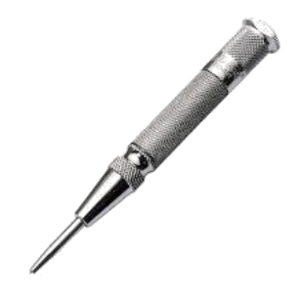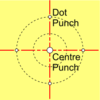Dot Punch: Difference between revisions
From DT Online
(Created article) |
m (Added Category) |
||
| Line 38: | Line 38: | ||
| <dtamazon product="B0006J4Q64" type="text">Starrett 18A Automatic Centre Punch with Adjustable Stroke</dtamazon> | | <dtamazon product="B0006J4Q64" type="text">Starrett 18A Automatic Centre Punch with Adjustable Stroke</dtamazon> | ||
|} | |} | ||
[[Category:Punches]] | |||
Revision as of 09:05, 14 May 2016
Dot Punches are similar to Centre Punches but have a sharper point by being ground to an angle of 60 degrees (in a similar manner to a Scriber).
Uses
Dot Punches are held at an angle to the intersection or line to be marked and either lightly struck once with a hammer. Alternatively, Automatic Dot Punches are available, as shown, which are simply pushed down to activate.
Note:
If Dot Punches are used to mark where a large hole crosses each of its centre lines, for instance, accurate work would result in each ‘dot’ being halved across its diameter.
DT Online Buyers' Guide
The lowest cost option is to use a hand-held punch with a hammer but a wide range of automatic punches are available - both Dot Punches and Centre Punches.
- In general, Dot Punches have a sharper point (i.e. 60° instead of 90°) and need only the lower ranges of impact force (e.g. 20N to 50N).
- Automatic punches are simply pushed down against the work-piece and do not need to be struck - indeed, should NOT be struck with a hammer.








